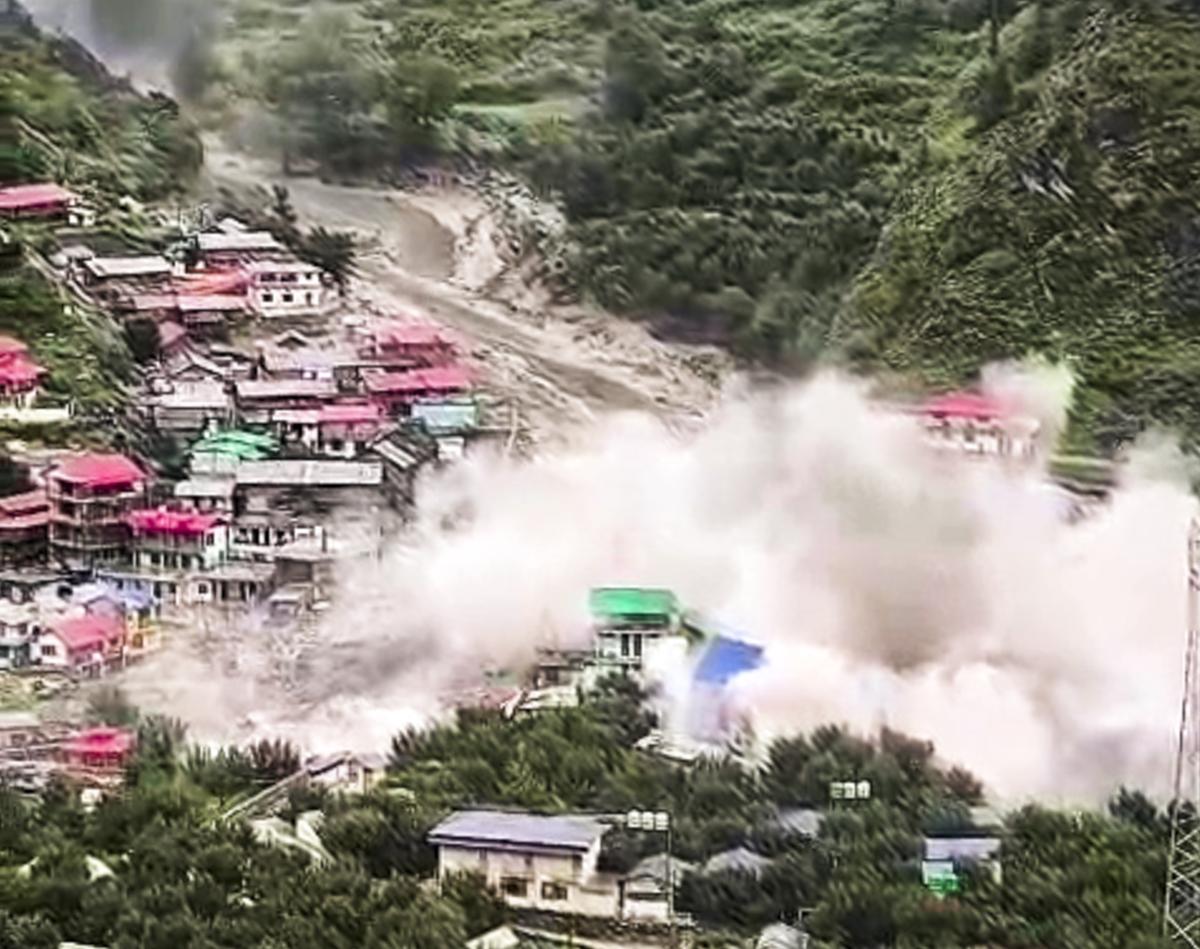Uttarkashi’s Flash Flood Disaster and What It Means for Kashmir’s Climate Future
By: Javid Amin | 05 Aug 2025
When a Peaceful Village Becomes Ground Zero
In the quiet, high-altitude Himalayan hamlet of Dharali, nestled near Harsil in Uttarkashi district, serenity was shattered at dawn on August 5, 2025. The skies opened violently, dumping more than 100 mm of rain in less than an hour, triggering a deadly cloudburst that sent a flash flood surging through the valley.
In a matter of minutes, homes, hotels, and entire livelihoods were swept into the raging Kheer Ganga River, now transformed into a torrential monster. Survivors described the wave as “a wall of water and rage.” For those who lost loved ones, the terror will last forever.
This tragedy was not just a cruel trick of nature—it was the predictable product of ecological breakdown, climate disruption, and unchecked human interference in one of the world’s most fragile mountain ecosystems.
Scene of a Disaster: What Happened in Dharali?
The timeline was short. The damage, immense.
At 4:30 AM, torrential rain began. By 5:15 AM, the cloudburst had overwhelmed the narrow catchment above Dharali. The Kheer Ganga, typically a gentle glacial stream, turned into a destructive force.
Confirmed Impacts:
-
4 deaths, multiple injuries
-
Over 15 people missing (unofficial estimates)
-
Roads and pedestrian bridges destroyed
-
At least 3 hotels and 20+ homes swept away
-
Power supply, cell towers, and broadband completely knocked out
Locals recount a scene of chaotic escape, with families clambering uphill in the dark, carrying children and elderly members on their backs.
“We heard a roar, then screams. It wasn’t rain—it was a bomb from the sky,” said Mahesh Rawat, a survivor.
The Rescue: Brave But Too Late?
The State Disaster Response Force (SDRF) was alerted by 6:30 AM. But access roads were already blocked by landslides and broken bridges. Helicopters from the Indian Air Force were deployed after visibility improved, but the first few hours were critical—and largely helpless.
Challenges Faced:
-
Landslides on approach roads
-
Communication blackout
-
Continuous rainfall hampering air drops
-
Lack of local emergency shelters
This was not the first time Uttarkashi witnessed such a disaster. But once again, the region was caught off guard. And that’s the real tragedy.
Unpacking the Science: Why Are Cloudbursts Increasing in the Himalayas?
Cloudbursts aren’t new in India’s Himalayas. But their frequency, intensity, and destructiveness have exploded in recent years.
How Cloudbursts Happen:
Cloudbursts typically occur when:
-
Warm, moisture-laden air rises rapidly (usually from plains)
-
It cools and condenses quickly as it hits the cold mountain air
-
A small catchment receives 100+ mm rain in < 1 hour, overwhelming drainage
Due to global warming, the atmosphere now holds more water vapor, leading to more concentrated rainfall events.
Recent Scientific Data:
-
IMD Report (2024): Cloudburst frequency in Western Himalayas has doubled in 10 years
-
Wadia Institute: Local warming in Uttarakhand is 2x higher than India’s average
-
UN IPCC: The Himalayas are among the top 10 climate hotspots globally
Why Kashmir Should Be Alarmed
Though the epicenter was Dharali, Kashmir Valley should hear the alarm bells loudest.
The Kashmir Himalayas, particularly the Pir Panjal and Zanskar ranges, share the same geological fragility and meteorological vulnerability. Similar flash floods, GLOFs (Glacial Lake Outburst Floods), and landslides are already rising across:
-
Gurez & Bandipora: Glacier-fed streams surging in summers
-
Doda & Kishtwar: Landslides triggered by road cutting and rains
-
Ramban & Banihal: Frequent slope collapses after every downpour
-
Srinagar: Still rebuilding after the 2014 floods which left 300+ dead
With rising unplanned urbanization, shrinking wetlands, and haphazard tourism infrastructure, Kashmir’s disaster clock is ticking.
The Human Hand: Making Nature’s Job Easier
Let’s be clear—this isn’t just climate change. It’s climate injustice.
Here’s how human activity magnifies these disasters:
| Human Action | Ecological Impact |
|---|---|
| Deforestation | Reduces water absorption; triggers landslides |
| Slope Construction | Weakens soil, leads to collapse under rain |
| Blocked Waterways | Redirects floods into villages |
| Over-tourism | Exceeds carrying capacity, strains sewage systems |
| Pesticide Runoff (Kashmir) | Kills wetlands, pollutes runoff channels |
| Shrinking Glaciers | Alters river flow, creates unstable lakes |
In places like Sonamarg and Pahalgam, hotels are built on floodplains, ignoring zoning laws. Dharali is a warning.
A History of Ignored Warnings
Experts have warned about all this before.
2013 Kedarnath Floods:
Killed 5,700+. Blamed on:
-
Blocked drains
-
Overconstruction
-
Weak disaster response
2014 Kashmir Floods:
Over 500 villages submerged. Yet, wetland encroachment continued. Dal Lake and Hokersar wetland shrank rapidly.
NDMA Reports:
Between 2017 and 2024, the National Disaster Management Authority released five urgent advisories. Very little implementation followed at the district level.
What Needs to Change — Now
To avoid turning every monsoon into a mass funeral, we need decisive, accountable action. Here’s a roadmap:
01. Scientific Mapping of Risk Zones
Use satellite LIDAR to demarcate:
-
Landslide hotspots
-
GLOF-prone lakes
-
Flood basins
02. Construction Freeze in Danger Zones
-
Impose permanent building bans in red zones
-
Audit and demolish illegal hotels/homestays on riverbanks
03. Strengthen Early Warning Systems
-
Install Doppler radars in vulnerable districts
-
Push real-time SMS alerts linked to IMD rainfall models
-
Community sirens and evacuation markers
04. Eco-Literacy in Schools
-
Teach climate, first aid, and emergency drills
-
Include indigenous disaster coping knowledge
05. Green Infrastructure Mandates
-
Ban concrete on slopes
-
Incentivize rainwater harvesting, green roofs, and bioengineering slope protection
Role of the Public: From Passive Victims to Active Guardians
Climate resilience begins with community empowerment.
-
Local panchayats must lead hazard zoning
-
Tour guides and hoteliers must undergo green certification
-
Youth groups should train in disaster volunteerism
-
Citizens must boycott illegal construction
A Call from the Mountains
As Dharali clears its mud, Kashmir must look in the mirror. Every cloudburst, every landslide is not an isolated event—it is part of a growing Himalayan emergency.
We cannot treat flash floods like bad weather. They are systemic failures—of planning, governance, and responsibility.
“Aaj Uttarkashi, kal hum ho sakte hain.”
“Today it’s Uttarkashi. Tomorrow, it could be us.”
The Himalayas are not just mountains—they are water towers, biodiversity treasure chests, and cultural anchors. Their destruction will not stay local. It will be national, even global.



